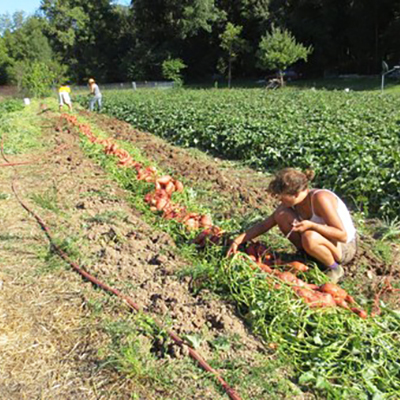By Jesse Frost
In recent years a great deal of interest has been building around the question of how to run a profitable, chemical-free farm without tillage. We all know what tillage does to soil, but the available information about how not to till on a commercial market garden scale has felt impractical or unusable, much of it geared towards home gardeners or mega grain operations in chemical monoculture. There has been, to be sure, very little in the way of guidance on how to approach a profitable, diversified no-till farm. That, however, is about to change.
Two new books stand poised to open the floodgates and relieve that information deficit in a big way, ushering in a new era for ecologically-minded no-till farmers, ranchers, and market gardeners who have always wanted to go no-till, but have been unsure of how. Though there are some important and notable overlaps in these two new books, both bring something unique to the conversation.
The first of these books is from well-known speaker and rancher Gabe Brown called “Dirt to Soil: One Family’s Journey into Regenerative Agriculture” (Chelsea Green, October 2018). It’s a memoir and manual hybrid that tells the story of Brown’s Ranch in North Dakota from its humbling and near-ruinous beginning years to its profitable, stacked enterprises of today. However, once you’re hooked into that story—and farmers of any size will be—Brown takes the second half of the book to break his methods down in fine detail, complete with case studies of other farms where his systems have worked.
What is so captivating about Brown’s story is how familiar it is. He was a new farmer and the farm he’d started wasn’t doing well. The natural elements were rebelling against him (or, as he suggests, trying to tell him something). Several consecutive disastrous years of hail and snow had him questioning whether or not farming was possible. Indeed, Gabe’s is the hard story of modern industrial agriculture. Quickly, though, it becomes a story about the changes he made, his unconventional path to success, and how focusing on soil health reduced his workload, increased his profits, and even inspired his son to stay on the farm.
A market gardener may have good reason to ask how a book about an operation as large as Brown’s (currently at 5000 acres of owned and leased land) could benefit them, but reading it answers that question quite thoroughly—Brown’s methods are adaptable. They are universal. He isn’t just telling you how he does things, he’s explaining the principles of soil health that guide each of his decisions. Perhaps more to the point, he’s showing those principles of soil health do not have to be sacrificed to be successful.
I mention that both books in this review offer something unique and for me Gabe’s book offers not only a glimpse at how large chemical-free no-till can be scaled up or down—effectively offering a large-scale version of regenerative, biological farming—but how animals can be incorporated, managed, and made profitable in a very digestible brand of detail. If animals are not a focus or interest of yours, this book can still be deeply satisfying. But note that livestock management is no small part of the book as it is a big part of Gabe’s approach to regenerative agriculture and no-till. That said, this book does not lack for information and inspiration for cropping ground, sequestering carbon, and growing better crops profitably.
Our second book comes from author/farmer Andrew Mefferd called “The Organic No-Till Farming Revolution: High Production Methods for Small Scale Farmers” (New Society Publishers, January 2019).
Without a doubt, having been written by the editor of this publication, Mefferd’s book is tailored to the GFM readership.
The book begins with a general (yet superb, but we’ll get to that) breakdown of the whys and hows of no-till. The bulk of the book is made up of interviews with successful, often highly-profitable, no-till growers from Maine to California (with a refreshing jaunt to Australia), some of whom have contributed to this publication in years past, others of whom are completely off the radar. The 17 grower interviews are compared to the author’s experience working on a no-till research farm 15 years ago.
Mefferd’s overview of no-till is smart and objective for how effectively it does not denigrate those who till, but simply highlights many of tillage’s inefficiencies. These are inefficiencies that most every farmer is already going to be familiar with—how tillage ties up time, requires fuel and equipment, and also depends on soil conditions. Too wet or too dry and tillage can be even more damaging to the soil life, water retention, and so on. These inefficiencies are then paired, or perhaps flipped, by Mefferd to be contrasted with what happens when you avoid tillage—how the weeds go down, the labor goes down, while the water-retention and life return.
Are there downsides to no-till? Sure, there can be and Mefferd objectively goes into those—slugs, for one, or potentially cooler soil in the spring for another—but to hear from these farmers in the interviews makes those negatives seem harmless in contrast to the negatives of tillage. Plus, many of these growers have found work-arounds or solutions because no-till, even when imperfect, has significant potential for profit, reduced labor, better food and better soil. In contrast to tillage, for these growers it was worth figuring it out.
There is something striking in reading through Mefferd’s interviews in that the range of different techniques that have been developed to manage without tillage are so diverse. There are cover-cropping farmers, farmers who mulch with straw or compost, cardboard-mulchers, and everything in-between. These farmers obviously did not get the memo that no-till was impractical or unscalable, and set forth quietly and effectively developing efficient no-till methods for small-scale production.
Fair warning that you will put down Mefferd’s book brimming with a dose of inspiration. However, it probably will not answer every question you have, because no book on no-till can do that. Though true of farming in general, no-till farming is especially void of a single unifying system. Rather it’s about a set of principles: namely, disturbing the soil as little as possible, keeping it planted as much as possible, and keeping it covered as much as possible.
How you interpret that for your own farm—given your scale, access to materials, tools, et cetera—will determine how you go about achieving a no-till system of your own. Vegetables and flowers all still grow the same way, it’s the soil prep where the nuance comes in.
That said, the value of Mefferd’s interviews is that they show you the array of options at your fingertips. If straw is a material you can access affordably, there are models for using that in these interviews. You hear about compost mulches from Paul and Elizabeth Kaiser at Singing Frogs Farm or how Shawn Jardnicek uses leaves in his roller-crimper system. Lots of cardboard at your disposal? Ricky Baruc and Deb Habib will serve as a great resource for how to employ it. An inspired grower can take one of these methods or hybridize a few, but this book will give you the confidence to try something new through the simple strategies of seventeen different successful no-till growers.
We have all heard for many years—sometimes even from our agricultural agencies—how we shouldn’t be tilling, how it disrupts the structure and life of the soil, but we have also been presented with very little in the way of alternatives. Thanks to Gabe Brown and Andrew Mefferd, however, we finally have something to work with—we finally have those alternatives. To be sure, the no-till movement has arrived, and we shouldn’t just make room on our shelves for these two books, but also for the flood of books on no-till farming that Brown and Mefferd will almost undoubtedly inspire.
Jesse Frost is a vegetable grower and freelance journalist in central Kentucky. He has written for The Atlantic, Civil Eats, Modern Farmer, Hobby Farms and others.
Both books are available from Growing for Market. Dirt to Soil by Gabe Brown is $19.95, or $15.96 for GFM subscribers with 20% off. The Organic No-Till Farming Revolution by Andrew Mefferd is $29.99, or $23.99 for GFM subscribers with 20% off.
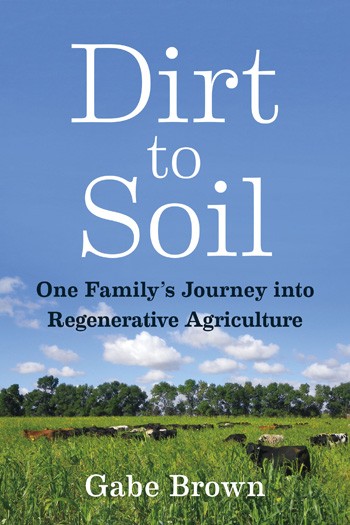
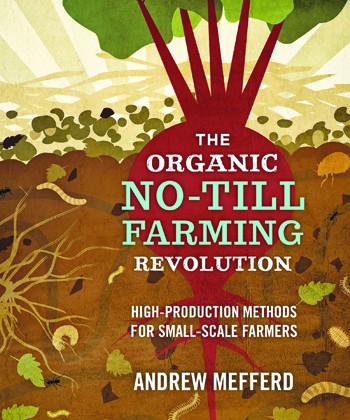
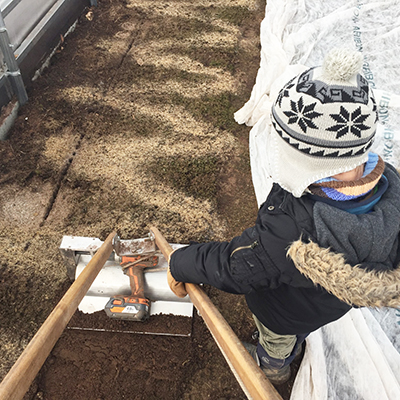

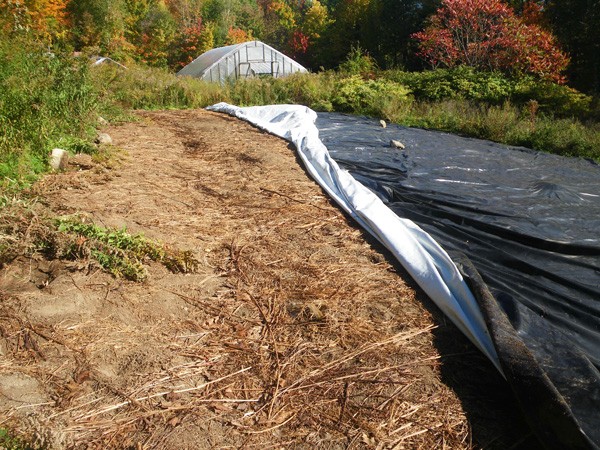 In the mid-1980s I had a farm in upstate New York and grew 20 acres of organic vegetables with machinery. It was organic, but not sustainable both for the use of fossil fuel and high level of personal burnout. I lost my joy of farming and never thought I would go back into it for my livelihood.
In the mid-1980s I had a farm in upstate New York and grew 20 acres of organic vegetables with machinery. It was organic, but not sustainable both for the use of fossil fuel and high level of personal burnout. I lost my joy of farming and never thought I would go back into it for my livelihood.
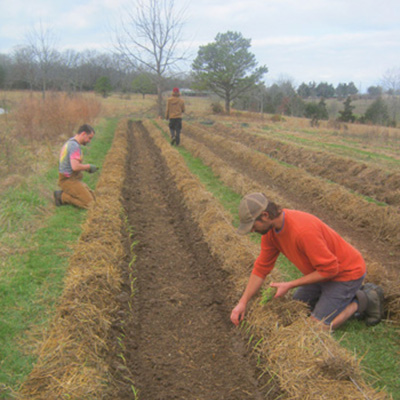

 My wife, Megan, and I grow cut flowers on half an acre of a twelve-acre property in Hurdle Mills, NC. We are in the heart of tobacco country. When we bought our property in 2013, our sales contract stipulated that the farmer had the right to harvest that year’s tobacco crop. Based on our best guesses, that marked at least the 100th consecutive year of tobacco/wheat rotations on this property. The farmer was kind enough to disc in the tobacco stubble after the harvest.
My wife, Megan, and I grow cut flowers on half an acre of a twelve-acre property in Hurdle Mills, NC. We are in the heart of tobacco country. When we bought our property in 2013, our sales contract stipulated that the farmer had the right to harvest that year’s tobacco crop. Based on our best guesses, that marked at least the 100th consecutive year of tobacco/wheat rotations on this property. The farmer was kind enough to disc in the tobacco stubble after the harvest.
 If you’ve been a subscriber to Growing For Market (or even if you haven’t), you’re probably familiar with the many advantages of no-till agriculture. No-till methods can reduce a farm’s carbon footprint, promote complex soil biology, and preserve and build organic matter.
If you’ve been a subscriber to Growing For Market (or even if you haven’t), you’re probably familiar with the many advantages of no-till agriculture. No-till methods can reduce a farm’s carbon footprint, promote complex soil biology, and preserve and build organic matter.
 Julia Asherman appeared on my radar screen a number of years ago because she was a regular presence at the Southern Sustainable Agriculture Working Group conferences where I’ve spoken many times. Colleagues pointed her out to me as a person to watch because she was tough and smart and she was going to make something of herself as a farmer. We became conference buddies. So, when I had the good fortune to get invited to speak at the Georgia Organics Conference in Athens this winter, I knew right away I wanted to take that opportunity to visit Julia at her place, Rag & Frass Farm in Jeffersonville, Georgia.
Julia Asherman appeared on my radar screen a number of years ago because she was a regular presence at the Southern Sustainable Agriculture Working Group conferences where I’ve spoken many times. Colleagues pointed her out to me as a person to watch because she was tough and smart and she was going to make something of herself as a farmer. We became conference buddies. So, when I had the good fortune to get invited to speak at the Georgia Organics Conference in Athens this winter, I knew right away I wanted to take that opportunity to visit Julia at her place, Rag & Frass Farm in Jeffersonville, Georgia.
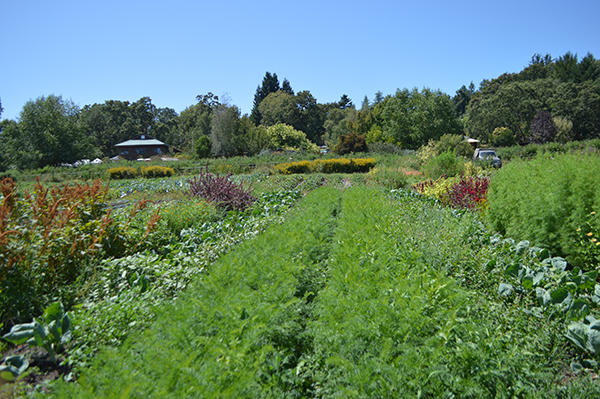 Farmer to Farmer Profile
Farmer to Farmer Profile
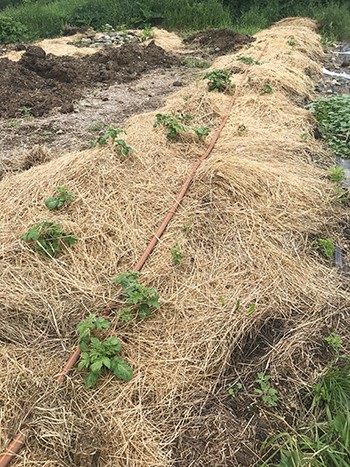 There are good reasons why quick-growing greens crops have gotten a lot of attention in no-till systems. But I wanted to try growing some less common no-till crops, so I grew test plots of potatoes and sweet potatoes on my farm this past year.
There are good reasons why quick-growing greens crops have gotten a lot of attention in no-till systems. But I wanted to try growing some less common no-till crops, so I grew test plots of potatoes and sweet potatoes on my farm this past year.
 The modern age could very well be termed the age of carbon. We have increased the amount of carbon dioxide (CO2) in the atmosphere by more than a third since the Industrial Revolution began. A gas that keeps heat from the sun contained within the earth’s atmosphere, CO2 makes up more than three-quarters of the greenhouse gas emissions in the world. At the same time agriculture is currently experiencing a carbon crisis, with 50-70% of the world’s carbon in farmland soils off-gassed into the atmosphere due to tillage. Carbon is the single most essential element in soil fertility as it aids soil structure development, water retention, nutrient retention, and biological processes.
The modern age could very well be termed the age of carbon. We have increased the amount of carbon dioxide (CO2) in the atmosphere by more than a third since the Industrial Revolution began. A gas that keeps heat from the sun contained within the earth’s atmosphere, CO2 makes up more than three-quarters of the greenhouse gas emissions in the world. At the same time agriculture is currently experiencing a carbon crisis, with 50-70% of the world’s carbon in farmland soils off-gassed into the atmosphere due to tillage. Carbon is the single most essential element in soil fertility as it aids soil structure development, water retention, nutrient retention, and biological processes. 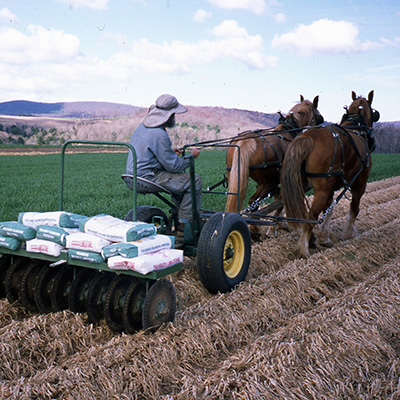
 When we started farming in 1983, there were few models of organic, horse-powered market gardening. So we used the traditional practices for growing field crops here in north-central Pennsylvania, preparing a seedbed with the moldboard plow, spring tooth harrow and cultipacker. We quickly realized we needed to put a whoa on moldboard plowing to dependably establish dryland produce.
When we started farming in 1983, there were few models of organic, horse-powered market gardening. So we used the traditional practices for growing field crops here in north-central Pennsylvania, preparing a seedbed with the moldboard plow, spring tooth harrow and cultipacker. We quickly realized we needed to put a whoa on moldboard plowing to dependably establish dryland produce.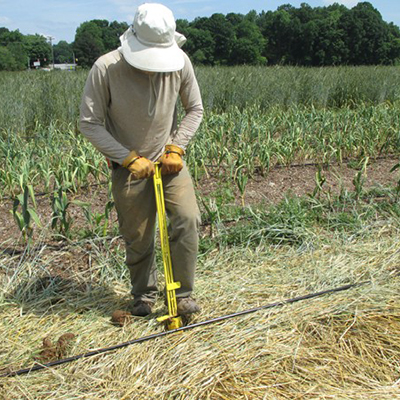
 Organic no-till and mulching systems are a huge time saver on our farm. They’ve allowed us to increase production while reducing labor on our six acres of vegetable production. This spring was our easiest year yet even though an illness in April made it difficult to leave the house. I owe the time savings to the roller crimper.
Organic no-till and mulching systems are a huge time saver on our farm. They’ve allowed us to increase production while reducing labor on our six acres of vegetable production. This spring was our easiest year yet even though an illness in April made it difficult to leave the house. I owe the time savings to the roller crimper. 
